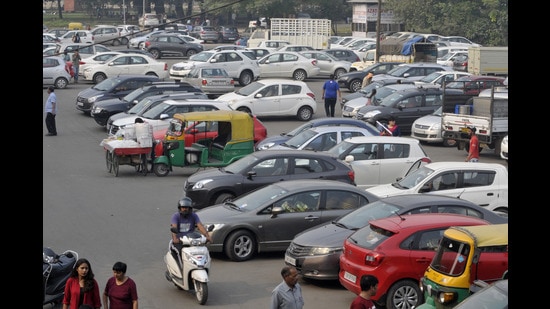A lot ailing Chandigarh’s parking system, RITES suggests fixes
In the note on “Parking Management in Chandigarh”, submitted with the Chandigarh administration, RITES, a multi-disciplinary consultancy corporation of the Indian Railways, lists several problems plaguing the city’s parking lots.
Highlighting problems in Chandigarh’s existing parking system, RITES has recommended multiple improvements, including heavy penalties for misuse of parking space, introducing community parking, and more reliance on public transport.

In the note on “Parking Management in Chandigarh”, submitted with the UT administration, RITES, a multi-disciplinary consultancy corporation of the Indian Railways, lists several problems plaguing the city’s parking lots.
There is no real-time tracking or data/report for analysis of the parking lots. Commuters waste considerable time in searching for a vacant parking spot, which causes traffic congestion, further leading to stress on users and pollution. Highlighting sub-optimal utilisation of space, RITES has also pointed out lack of flexibility in parking charges.
The corporation made a detailed presentation in a meeting with senior UT officials, chaired by UT adviser Dharam Pal on Thursday.
RITES was appointed by the administration last year to prepare a comprehensive mobility plan for the city. A final report will be submitted by June.
Short-term solutions
In its note, RITES suggested that the administration’s parking enforcement policy must have a provision for strict penalties for misuse or encroachment of public land and pedestrian space, diversion of parking area for other purpose, over charging, etc.
Private vehicles must be parked on a fully-paid, rented or owned space, based on the “user pays” principle and introduction of hourly rates.
More areas like corners, edges and undeveloped land, which are currently lying waste, can be used.
Also, efficiency of parking spaces can be maximised by classifying them into long- and short-term parking areas, with a reflective tariff plan.
Staff buses to discourage use of personal vehicles, and staggering of school and office timings to reduce the parking demand can also help decongest parking.
Big use of technology
In the mid-term, the administration should incorporate information technology (IT) solutions for assessing parking demand and helping users know the availability of vacant spots. Easy payment mechanism through mobile payment platforms, including e-wallets, and debit and credit cards, should be introduced.
Where space is limited, multi-level parking may be planned instead of new parking lots.
More reliance on public transport
In the long run, city-wide mass public transport system needs to be provided to control parking demand, states the RITES note.
The administration should review minimum off-street parking requirements in zoning regulations and development policies.
The parking supply in each sector may be increased by using neighbourhood commercial and institutional parking lots on rental basis, which may be run by the registered Residents’ Welfare Associations (RWAs) post their operational hours.
Areas with public transport connectivity should have effective parking pricing, limited parking area and strong penalty for parking violations.
BOX:
City’s parking infrastructure
Chandigarh currently has 89 parking lots on around 5.22 lakh square metre area, which can house 22,725 equivalent car spaces (ECS).
What ails the parking system
Real-time tracking of vacant spots missing
Time is wasted in searching for a parking spot, leading to traffic congestion, stress to users and pollution
Sub-optimal space utilisation
No flexibility in parking charges
RITES’ suggestions
Strict penalty against parking space misuse
Classifying parking lots into long- and short-term
Infusing IT in parking management
Multi-level parking in existing lots
More use of public transport
Community parking
Review of minimum parking space requirements in zoning plans.





